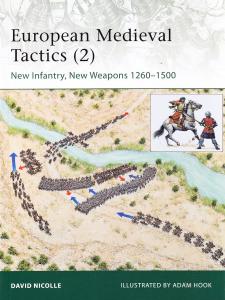European Medieval Tactics (2). New Infantry, New Weapons 1260–1500
CODICE: ISBN 1849087393 EAN 9781849087391
AUTORE/CURATORE/ARTISTA :
Author: David Nicolle Illustrated by: Adam Hook
EDITORE/PRODUTTORE : Osprey Publishing
COLLANA/SERIE : Elite, 189
DISPONIBILITA': In esaurimento
TITOLO/DENOMINAZIONE:
European Medieval Tactics (2). New Infantry, New Weapons 1260–1500
PREZZO : EUR 22,50€
CODICE :
ISBN 1849087393
EAN 9781849087391
AUTORE/CURATORE/ARTISTA :
Author: David Nicolle Illustrated by: Adam Hook
EDITORE/PRODUTTORE:
Osprey Publishing
COLLANA/SERIE:
Elite, 189
ANNO:
2012
DISPONIBILITA':
In esaurimento
CARATTERISTICHE TECNICHE:
64 pages
51 b&w illustrations, 8 color illustrations
Paperback
cm 18,5 x 24,5 x 0,4
gr 220
DESCRIZIONE:
Publisher's description:
With the development in the 13th century of co-operative tactics using crossbowmen and heavy spearmen, circumstance began to arise in which the charge by Muslim horse-archers, and then by European armoured knights, could be defied. Infantry were far cheaper and easier to train than knights, and potentially there were far more of them. Tactics emerged by which more numerous and more varied infantry played an increasing part in battles. This book traces these and other examples of this 'jerky' and uneven process through its regional differences, which were invariably entwined with parallel cavalry developments - the balanced army of 'mixed arms' was always the key to success. By the time serious hand-held firearms appeared on battlefields in large numbers in about 1500, the face of medieval warfare had been transformed.
From the back cover:
This second part of the author's study of tactical changes during a thousand years of European history describes the journey from essentially feudal to fundamentally professional fighting forces. The methods by which armies were raised and paid for dictated the level of troops' equipment and capabilities, and thus both their battlefield tactics and the ways in which rulers could wage war. Troops raised by small but wealthy Italian city-states differed markedly from those of emerging nation-states like England and France, or of the sprawling Holy Roman Empire. While balanced forces of infantry, heavy and light cavalry were necessary almost everywhere, warfare in Western and Central Europe differed from that between Christians and Muslims in Spain, and from the wars on Christendom's eastern frontiers. The text is illustrated with explanatory battle-plans of important engagements, and with full-colour tactical scenarios that bring them to life.
Contents:
Introduction
Background - the experience gained from defeats at the hands of the 13th-century Mongol invasions, and of Muslim armies in the Middle East
Development of infantry weapons and tactics as result of meeting these basically light cavalry enemies. (e.g. Tagliacozzo, 1268; Falkirk, 1298; Courtrai, 1302)
The decline of lance and the rise of close-quarter cavalry weapons - confusion of tactics (e.g. Najera, 1367; Aljubarotte, 1385; Castagnaro, 1387)
Crossbow and longbow - reasons for divergence between mainland European and English armies - how each type worked alongside cavalry and dismounted men-at-arms (e.g. Crecy, 1346; Agincourt, 1415)
'Blip' in rise of infantry dominance as heavier cavalry armour becomes arrow-proof (e.g. San Romano, 1432)
Decline of archery in favour of combined-arms infantry armies - bows subsidiary to massed pikes and halberds (e.g. Grandson, 1476)
Increasing importance of field artillery (e.g. Castillon, 1453) and hand-held firearms (e.g. Cerignola, 1503)
Plate commentary
Bibliography
Index
Index:
page 4 INTRODUCTION
10 THE 13TH-14TH CENTURY INFANTRY REVIVAL
From feudal militias to 'mercenaries'
Italian armies and tactics
The British Isles
The Empire and Scandinavia
France
21 THE CHALLENGE OF BOW & CROSSBOW
The 14th to mid-15th centuries:
Italian urban militias and condottieri - Venice
France: indentured troops - urban forces
The British Isles: coastal militias
The Empire and Scandinavia: local forces - urban militias - leagues - 'free knights' - crossbowmen
Diversity of troop types and tactics: elite infantry - professional men-at-arms - Flemish mixed-arm infantry - archers - Scottish and Swiss spearmen
34 FROM KNIGHT TO MAN-ALARMS
The 14th to mid-15th centuries:
France: the arrière ban and indentured companies
England: mixed indentured companies - 'hobelar' light cavalry
Italy: mercenary knights - the Venetian army - Angevin and Spanish southern Italy
The Empire and Eastern Europe: Western and Eastern influences
Strategy and tactics: French defensiveness and English aggression
41 FORTIFICATIONS & FIREARMS
Up to the mid-15th century:
Defensive co-operation between French regional networks blockades and convoys
Field fortifications: bastides, stakes, and 'wagon forts'
Firearms: effectiveness and limitations of artillery - cost - the spread of handguns
48 THE DAWN OF MODERN WARFARE
The second half of the 15th century:
Infantry development
Attitudes to war: Italy - France
Continuing importance of armoured cavalry - skill-at-arms
Italian tactics
Firearms
58 EXTERNAL CHALLENGES
Warfare on the frontiers of Western Christendom:
The Baltic
Hungary
Spain
62 BIBLIOGRAPHY
64 INDEX
GENERE: Libri ,Monografie ,



